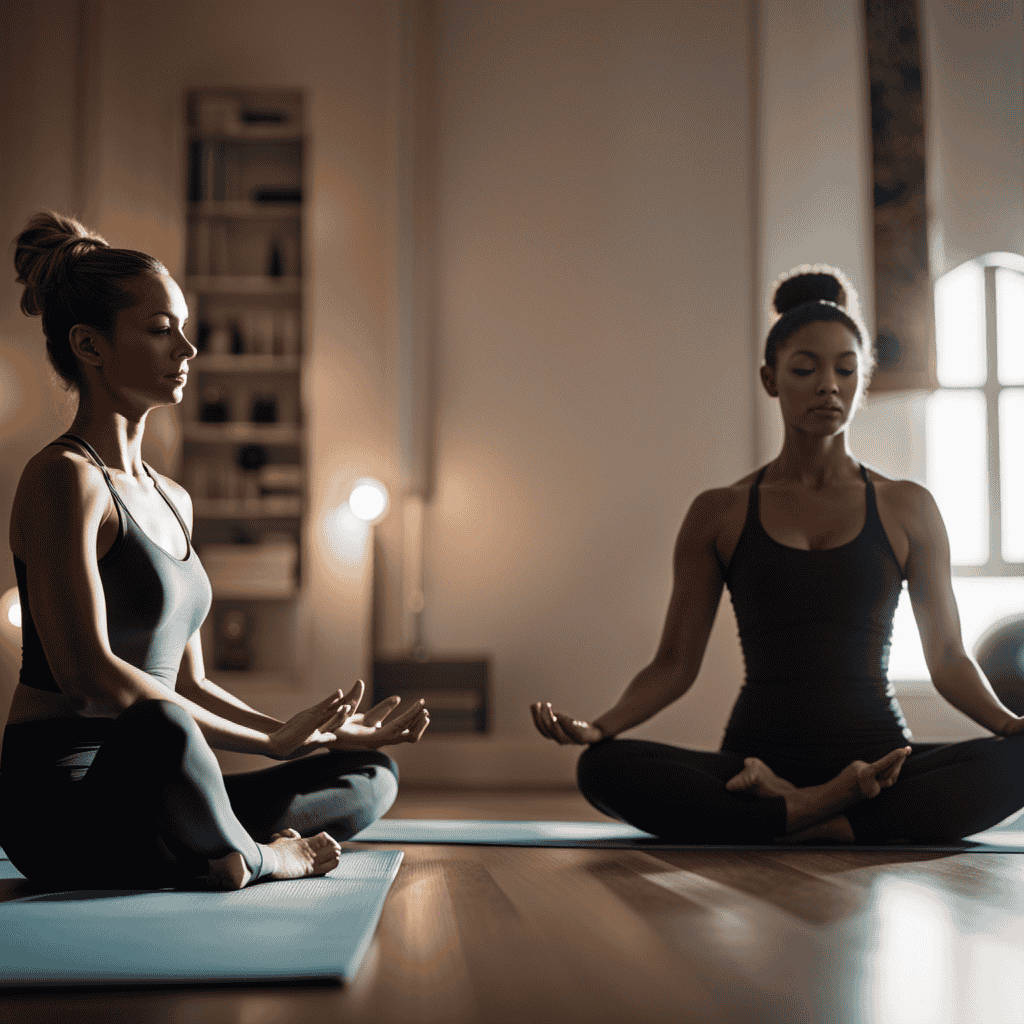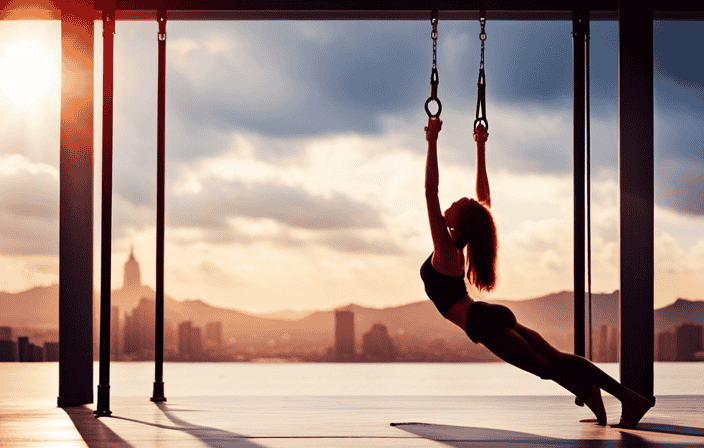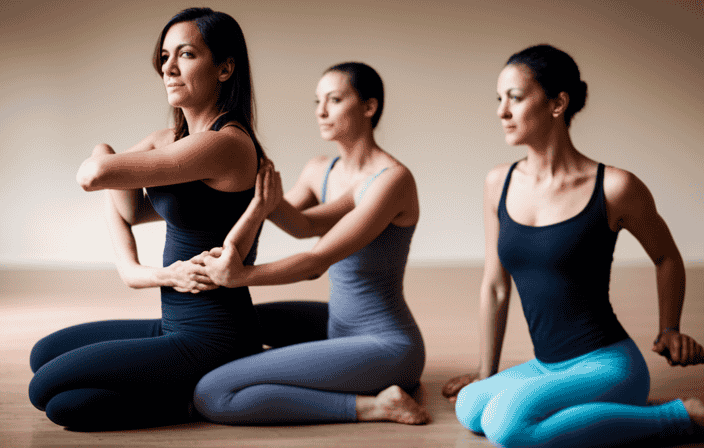Yoga and Pilates are two widely practiced forms of mindful exercise that provide numerous advantages for both physical and mental health. Despite both emphasizing relaxation, enhanced flexibility, and core strength, each practice has its own unique characteristics.
In this article, we will delve into the unique benefits of yoga and Pilates, explore why one might choose Pilates over yoga, discuss its beginner-friendly nature, and examine how both practices can contribute to weight loss.
So, let’s dive deeper into the world of yoga and Pilates to discover which mindful exercise is right for you.
Key Takeaways
- Yoga emphasizes breathwork, flexibility, and spiritual growth
- Pilates focuses on core strength, stability, and body alignment
- Both practices promote physical and mental well-being
- Pilates is preferred by some individuals for its precise focus on core strength, improved posture, and toned physique.
Yoga Benefits
I find that practicing yoga brings numerous benefits to both my physical and mental well-being.
Yoga is a wonderful practice for stress relief, as it helps me relax and unwind after a long day. The combination of deep breathing and gentle, flowing movements allows me to release tension and find a sense of calm.
Additionally, yoga has helped me cultivate mindfulness. By focusing my attention on the present moment and being fully present in my body, I have developed a greater sense of awareness and a deeper connection with myself. This has not only improved my mental clarity and focus but has also enhanced my overall sense of well-being.
Overall, yoga has become an important tool in my self-care routine, providing me with a space to find peace and rejuvenation.
Pilates Benefits
Pilates offers numerous benefits such as promoting relaxation, improving flexibility and balance, enhancing mental focus and mindfulness, increasing strength and endurance, reducing the risk of chronic diseases, focusing on core strength and stability, improving posture and body alignment, enhancing body awareness and control, building lean muscle mass, and helping alleviate back pain. It is a versatile exercise method that can be beneficial for various individuals, including those seeking rehabilitation and athletes looking to enhance their performance.
Pilates has been widely used for rehabilitation purposes due to its focus on core strength and stability. It helps improve muscle imbalances, correct postural alignment, and enhance body control, making it an effective tool for recovering from injuries or managing chronic conditions. Additionally, Pilates can be customized to meet the specific needs and goals of athletes. It helps athletes develop strength, flexibility, and functional movement patterns, which can enhance their performance and reduce the risk of injuries. Whether you are looking to recover from an injury or improve athletic performance, Pilates can be a valuable addition to your fitness routine.
| Pilates for Rehabilitation | Pilates for Athletes |
|---|---|
| – Helps improve muscle imbalances | – Enhances performance |
| – Corrects postural alignment | – Reduces the risk of injuries |
| – Enhances body control | – Develops strength and flexibility |
| – Aids in injury recovery | – Improves functional movement patterns |
Why Choose Pilates?
One reason to choose Pilates is for its versatility and ability to cater to different fitness goals and needs. Here are three advantages of Pilates that make it a great choice for beginners:
-
Low Impact: Pilates is a low-impact exercise method, which means it is gentle on the joints and suitable for people of all fitness levels. This makes it a great option for beginners or those recovering from injuries.
-
Core Strength: Pilates focuses on developing core strength and stability. By targeting the deep muscles of the abdomen, back, and pelvis, Pilates helps improve posture, reduce back pain, and enhance overall body awareness and control.
-
Progression: Pilates starts with basic exercises and gradually progresses to more challenging movements. This allows beginners to build strength, flexibility, and endurance over time. Whether you choose to join Pilates classes or follow instructional videos, there are plenty of resources available to help you start your Pilates journey.
Beginner-Friendly Pilates
Starting with basic exercises in Pilates allows newcomers to gradually develop strength and flexibility. Pilates progression is designed to ease beginners into the practice, ensuring they can build a solid foundation before moving on to more complex movements. This makes Pilates an ideal choice for those who are new to the practice and may not have much experience with exercise.
Whether joining a Pilates class or following instructional videos, newcomers can learn the proper techniques and movements at their own pace. As they continue with their Pilates journey, they will notice improvements in their strength, flexibility, and overall fitness.
By starting with the basics, newcomers can set themselves up for success and progress in their Pilates practice.
Pilates for Weight Loss
I found that incorporating Pilates into my fitness routine has been effective for weight loss. Pilates is known for building lean muscle mass, which in turn increases metabolism and contributes to weight loss. It also supports overall fat loss and helps achieve a toned physique.
If you’re a beginner, Pilates is a great option as it starts with basic exercises and progresses gradually. It helps develop strength and flexibility while providing a foundation for more complex movements.
To maximize weight loss with Pilates, it is recommended to combine it with aerobic exercises and maintain a healthy diet. This combination can further enhance the calorie-burning process and promote sustainable weight loss.
So, whether you’re new to Pilates or looking to lose weight, incorporating Pilates into your fitness routine can be a beneficial choice.
Some tips for beginners:
- Start with beginner-friendly Pilates exercises.
- Join Pilates classes or follow instructional videos for proper guidance.
Key Differences
When comparing yoga and Pilates, it is important to understand the key differences between the two practices.
Yoga emphasizes breathwork, flexibility, and spiritual growth, drawing from ancient traditions.
On the other hand, Pilates focuses on core strength, stability, and body alignment, rooted in controlled movements.
While both practices promote physical and mental well-being, they have distinct characteristics that may appeal to different individuals.
In terms of benefits, both yoga and Pilates promote relaxation, improve flexibility and balance, enhance mental focus, and increase strength and endurance.
However, Pilates has a more precise focus on core strength and stability, resulting in improved posture and reduced back pain.
It also helps build lean muscle mass and provides a stronger and toned physique.
Yoga, on the other hand, offers a deeper focus on breathwork and mindfulness, enhancing body awareness and control.
When deciding between yoga and Pilates, it ultimately comes down to personal preference and fitness goals.
If you are looking for a practice that emphasizes core strength and stability, Pilates may be the right choice for you.
On the other hand, if you are seeking a practice that combines physical movement with spiritual growth, yoga may be a better fit.
Both practices offer unique benefits, so it is important to choose the one that aligns with your needs and preferences.
Similarities and Overlapping Benefits
Both practices have overlapping benefits that contribute to physical and mental well-being. Yoga and Pilates are both mindful exercises that focus on the mind-body connection. They encourage individuals to be present in the moment and cultivate a sense of mindfulness.
- Both Yoga and Pilates promote relaxation and stress relief.
- They improve flexibility, balance, and body awareness.
- Both practices enhance mental focus and mindfulness.
- Yoga and Pilates increase strength, endurance, and core stability.
- They also help improve posture and body alignment.
By incorporating these practices into your routine, you can experience the numerous benefits they offer.
Whether you choose Yoga or Pilates, both practices can help you achieve a greater sense of physical and mental well-being. So, take the time to explore and find the practice that resonates with you and your goals.
Pilates and yoga both require focus on core strength and stability. While yoga emphasizes breathwork, flexibility, and spiritual growth, Pilates focuses on core strength, stability, and body alignment. Both practices promote physical and mental well-being, but they have different areas of emphasis.
Yoga is known for its benefits in improving mental well-being. It promotes relaxation and stress relief, enhances mental focus and mindfulness, and increases body awareness and control. Yoga draws from ancient traditions and incorporates breathwork and meditation to cultivate a sense of inner peace and harmony.
On the other hand, Pilates is renowned for its ability to strengthen the core muscles and improve overall body alignment. It helps alleviate back pain, enhances body awareness and control, and builds lean muscle mass. Pilates is rooted in controlled movements and precise focus on core strength and stability. It provides a foundation for more complex movements and can result in improved posture and reduced back pain.
To summarize, while yoga is beneficial for mental well-being, Pilates is focused on core strength. Both practices offer a holistic approach to mindful exercise and can contribute to overall physical and mental health.
| Yoga | Pilates |
|---|---|
| Emphasizes breathwork, flexibility, and spiritual growth | Focuses on core strength, stability, and body alignment |
| Promotes relaxation and stress relief | Alleviates back pain |
| Enhances mental focus and mindfulness | Builds lean muscle mass |
| Increases body awareness and control | Improves posture and body alignment |
| Provides a sense of inner peace and harmony | Enhances body awareness and control |
Frequently Asked Questions
Can yoga or Pilates help with specific chronic diseases or conditions?
Yoga can help with anxiety by promoting relaxation, reducing stress, and enhancing mental focus. Pilates may benefit those with fibromyalgia by improving strength, flexibility, and body awareness, potentially reducing pain and fatigue.
What are the key differences between the breathing techniques used in yoga and Pilates?
The key differences between the breathing techniques used in yoga and Pilates are that yoga emphasizes deep, slow breathing to promote relaxation and mindfulness, while Pilates focuses on lateral breathing to engage the core muscles. Both techniques offer similar benefits for stress relief and mental well-being. When choosing between yoga and Pilates for mindfulness practice, consider your personal preferences and goals.
Can Pilates be practiced by people with back pain or injuries?
Yes, Pilates can be practiced by people with back pain or injuries. Modifications can be made to accommodate individual needs, and Pilates is often recommended for rehabilitation purposes to strengthen the core and promote proper alignment.
Are there any age restrictions for practicing yoga or Pilates?
There are no specific age limitations for practicing yoga or Pilates. Both can be modified to suit different fitness levels and abilities. Both practices offer numerous mental health benefits, such as promoting relaxation and reducing stress.
How often should one practice yoga or Pilates to see noticeable results?
To see noticeable results, I find that practicing yoga 2-3 times a week is effective, while for Pilates, consistency is key. Aim for 3-4 sessions per week to improve strength, flexibility, and posture.
Conclusion
In conclusion, both yoga and Pilates offer numerous benefits for physical and mental well-being. They promote relaxation, improve flexibility and balance, and enhance core strength and stability.
However, one interesting statistic to note is that Pilates has been found to reduce back pain by up to 36% in individuals who practice it regularly. This makes Pilates a great choice for those looking to improve their posture and alleviate back discomfort.
Ultimately, the decision between yoga and Pilates depends on personal preferences and goals.










